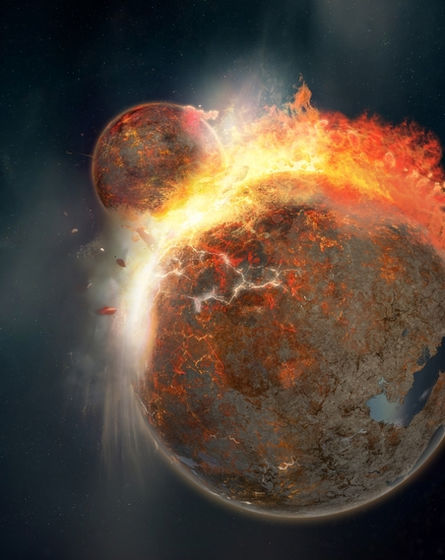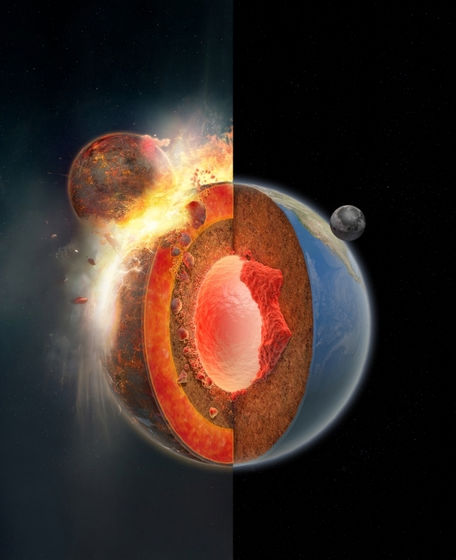It turns out that there are two huge remnants of ancient planetary collisions inside the earth, and may be related to the formation of the 'moon'

Deep within the Earth is a huge mass of material twice the size of the moon. Researchers at Arizona State University studied this huge chunk of material and discovered that it is the remains of an ancient planet that collided with Earth.
Moon-forming impactor as a source of Earth's basal mantle anomalies | Nature

ASU researchers discover Earth's blobs are remnants of an ancient planetary collision | ASU News
https://news.asu.edu/20231101-asu-researchers-discover-earths-blobs-are-remnants-ancient-planetary-collision
In the 1980s, geophysicists made a surprising discovery. The discovery was that ``two clusters of rare material the size of continents exist deep near the center of the Earth.'' One mass of this material exists beneath the continent of Africa, and the other lies beneath the Pacific Ocean.
Research over the past decade has also revealed that each blob is about twice the size of the moon and likely contains a different proportion of elements than the surrounding mantle. This mass of material, which is twice the size of the moon, is called ' LLSVP .'
In the latest research investigating where this LLSVP came from, it has been pointed out that LLSVP may be debris from a planetary collision that occurred billions of years ago. The mystery of LLSVP formation was investigated by a research team from the Arizona State University School of Earth and Space Exploration, led by Qian Yuan, an Arizona State University graduate and a postdoctoral researcher at the California Institute of Technology. The paper was published in the academic journal Nature on November 1, 2023.

Scientists have been aware of the existence of LLSVPs, large blobs of unusual composition and unknown origin deep within the Earth since the 1980s. LLSVP is so huge that if it were placed on the surface of the earth, it would create a layer about 60 miles (about 100 km) thick.
It is hypothesized that the moon was born in the aftermath of a collision between the Earth and a small planet called Theia, but no trace of Theia has been found in the asteroid belt or meteorites. However, according to Yuan and his research team, most of Theia may have been absorbed into the ancient Earth and formed LLSVP. It has also been pointed out that the moon may have been formed by fragments generated by Theia's impact.
Professor Steven Desch, of Arizona State University's School of Earth and Space Exploration, said: ``The moon's interior appears to contain material representing both pre-impact Earth and Theia, but it is unclear what remains of Theia are on Earth. It was thought that it had been 'erased' and homogenized by the Earth's internal dynamics (such as mantle convection) over billions of years.For this reason, our research shows that 'shards' of Theia are still on Earth. This is the first study to demonstrate that it exists at the boundary between the core and mantle of the Earth.'

Researchers discovered LLSVP by measuring seismic waves traveling through the Earth. LLSVPs deep in the Earth have an unusually high iron content, making them very slow propagators of seismic waves passing through them. As a result, even in the 1980s, researchers were able to recognize the existence of ``huge masses with different material compositions'' deep within the Earth.
Professor Ed Garnero, who participated in the study, said, ``The lumps that exist inside the Earth seem to be the remains of the planetary collision that formed our moon. The huge mass is material that came from outside the earth.'
When Mr. Yuan, who led the research team, heard that ``the moon contains a relatively large amount of iron'' and ``no traces of Theia, which crashed into the Earth and caused the formation of the moon, have been found.'' It seems that he came up with the possibility that LLSVP was formed from the remains of Theia.
The research team modeled various scenarios for Theia's chemical composition and its impact on Earth. Simulations of each model then show that Theia could have led to both LLSVP and the formation of the moon after it hit Earth.

A case in which Theia splits into LLSVP and the moon has been revealed through simulations. Simulations show that much of the energy generated when Theia hit Earth remains in the upper half of the mantle, and that the mantle in the lower half of the Earth remains cooler than originally estimated, never fully melting and causing Theia to remain in the upper half of the mantle. It appears that the iron-rich material from the source may have remained as LLSVP.
Furthermore, by conducting simulations of mantle convection, it has been revealed that iron-rich materials originating from Theia may sink and accumulate in the Earth's mantle. Professor Mingming Li of Arizona State University, who participated in the study, said, ``There is a good possibility that materials derived from Theia will remain in the Earth's mantle for about 4.5 billion years.''
Travis Gabriel, one of the co-authors of the study, said, ``By looking inside the Earth rather than outside the Moon, we can discover traces of the catastrophe that occurred in the ancient universe, the giant impact that formed the Moon. 'We were able to do that.'
Related Posts:
in Science, Posted by logu_ii







